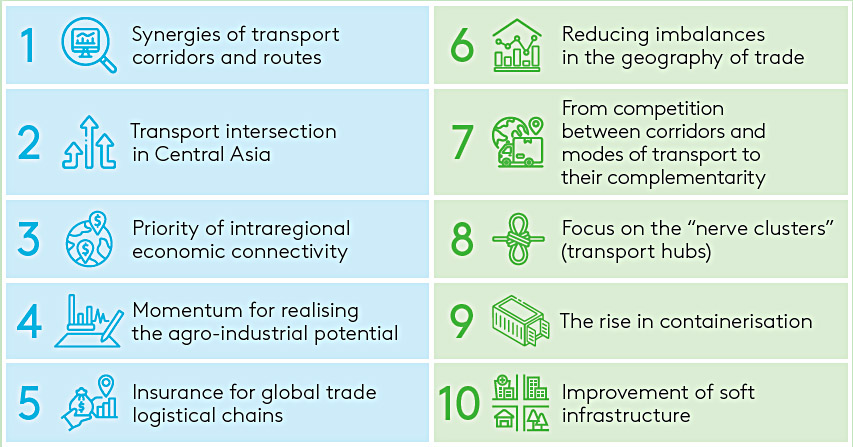The Eurasian Transport Network is a system of interconnected latitudinal and longitudinal international transport corridors and routes, facilitating intra- and trans-continental connectivity for Eurasian countries. It builds upon over 50,000 km of international east-west and north-south transport corridors, linking Asia, Europe and the Middle East. Their interconnection generates synergies resulting in up to 40% of additional freight traffic.
The Eurasian Transport Network consists of five key international transport corridors: the Northern, Central and Southern Eurasian Corridors, TRACECA, and the International North-South Transport Corridor (INSTC), along with branch lines and regional routes.
The Eurasian Transport Network today

The EDB introduced the concept of a Eurasian Transport Network in 2021, and this report presents its detailed framework. The concept emphasises the importance of interconnectedness and complementarity of Eurasian transport corridors to enhance transport connectivity, reduce trade-related costs and facilitate access to international markets, especially for land-locked developing countries (LLDCs) and inland areas.
The Eurasian Transport Network Concept consists of ten systemic elements.
The Eurasian Transport Network Concept

Three years ago, the EDB released a report titled The International North–South Transport Corridor: Promoting Eurasia’s Intra- and Transcontinental Connectivity, which estimated that connecting international transport corridors would yield a 40% increase in freight traffic. In 2024, this projection was fully confirmed by the dynamic development of the INSTC and its linkage to TRACECA.
The advancement of the Eurasian Transport Network is paving the way for the establishment of a transport hub in Central Asia. The development of multimodal transport and transit corridors is the only viable solution for Central Asian countries due to the significant distances between trade partners. Establishing a transport hub will facilitate an increase in international traffic, including transit. The EDB projects that freight traffic along the three main corridors running through Central Asia will increase by 1.5 times to 95 million tonnes by 2030. Container traffic is expected to grow even more rapidly, by almost two-thirds, reaching 1.7 million TEU.
The Eurasian Transport Network holds particular importance for Central Asian countries. Enhanced intra-regional economic connectivity will lead to lower transportation costs between countries along the corridor and to seaports.
The Eurasian Transport Network will help reduce imbalances in the geography of trade across Eurasia. For example, calculations using the International Trade Center gravity model estimate that the untapped trade potential between India and Central Asian countries is twice the five-year average of actual trade between them, primarily due to poor transport connectivity and high transport costs.
The full version of the report Eurasian Transport Network is available at the EDB website.